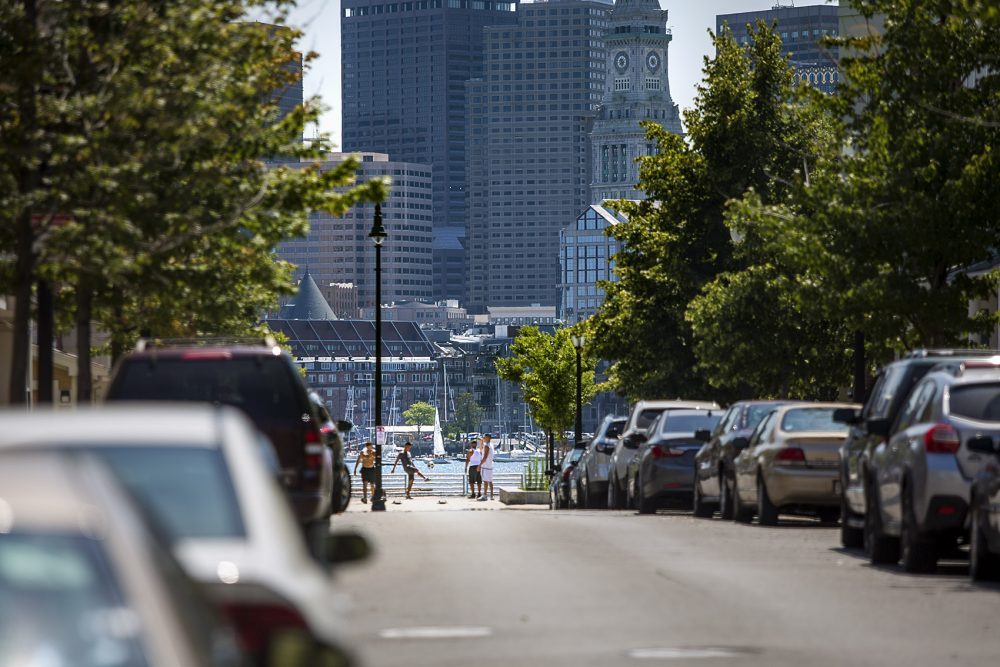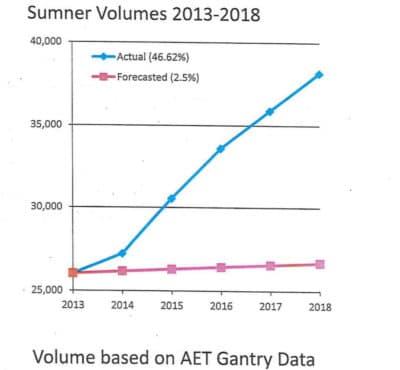Advertisement
Fed-Up Lawmakers Reach For Solutions To Eastie Traffic

Vehicles are entering the Sumner Tunnel at "unprecedented levels," thousands of rides on services such as Uber and Lyft head to and from Logan Airport each day and on residential streets, traffic backs up for hours on end.

Residents, lawmakers and transit officials agree: thanks to several compounding factors, the congestion in East Boston has reached a critical mass. The Department of Transportation is working to come up with a long-term solution, but in the meantime, Rep. Adrian Madaro and Sen. Joseph Boncore want to tackle the issue through legislation.
The duo filed a package of bills that would require the state to conduct an in-depth traffic study, implement a pilot program to change the Sumner Tunnel's tolls based on travel time and add new fees on ride-sharing trips.
"I don't ever remember a time when traffic was as bad as it is right now in East Boston," Madaro said. "You're talking congestion throughout every arterial street in East Boston. It is not just on the highway or just on the main streets. These are dense residential streets that have never experienced traffic before that are now under siege."
State officials say the situation in East Boston stems not from a single stressor but instead from a combination of trends. One of the biggest has been the rise of GPS-enabled navigation apps, which often direct drivers to side roads as a way to avoid typical highway traffic.
Another component is the airport. Logan saw an increase of about 5 million passengers per year, or about 15 percent, between 2015 and 2017, according to state data. That means more trips are headed through East Boston to get there, particularly after a change in policy about two years ago allowed ride-share apps to make airport pickups.
The Sumner Tunnel has also seen a surge of traffic in recent years that took leaders by surprise. In 2013, state estimates forecast that daily traffic volume would increase a total of 2.5 percent over the next five years. Data released last fall showed that traffic during that span actually increased more than 46 percent.
Advertisement
"That is an unheard of amount of growth that I don't think anyone expected," Transportation Secretary Stephanie Pollack said at a MassDOT board meeting last week.
In 2017, MassDOT removed toll booths leading to the tunnel as part of a broader switch to electronic tolling. But that move alone did not cause the problem — a state report released last fall shows that traffic in the Sumner had already been increasing at a fairly steady rate since 2014. Much of it comes from North Shore commuters heading into the city for work along Route 1A.
The state is weighing various measures, including the addition of a so-called "swing lane" to help traffic flow entering the Sumner Tunnel and a change to the lane structure on Storrow Drive. Lawmakers from East Boston want to force further action.
One bill in the Madaro-Boncore package would implement a congestion pricing pilot program for the tunnels that offers lower tolls at off-peak hours. Supporters hope that move would encourage drivers to avoid rush hour without penalizing those with inflexible schedules.
Two other bills filed in the House would require the state to perform a formal traffic study in East Boston and would grant municipalities the ability to file ballot initiatives approving tax surcharges to fund transportation projects.
A key focus of the legislative response has been on apps such as Lyft and Uber. One bill would impose a $3 fee on any ride-share vehicle entering or exiting Logan without a passenger, a practice known as "deadheading." Madaro said 5 million of the 12 million Uber and Lyft rides to or from Logan in 2018 had no passengers, contributing to congestion in the area.
"We want to create an environment where we're incentivizing drivers not to have these deadhead trips, because that means you're decreasing the amount of vehicles in East Boston," Madaro said.
Boncore and Madaro have also filed separate bills to increase the current 20 cent flat fee on ride-share uses, implemented in 2016, to an amount scaled to the ride's total cost. Madaro's version came as a collaboration with Sen. Brendan Crighton and the Metropolitan Area Planning Council.
Last year, the MAPC released a report on the effects of ride-share services that found the apps are often directly replacing mass-transit rides, contributing to congestion and leeching revenue from the MBTA.
"The real thing we're trying to push is behavior change," said Lizzi Weyant, director of government affairs for the MAPC. "The only way we actually reduce congestion is to get more people taking fewer cars, not more people taking more cars. If we can increase the fee, our goal is to ultimately change the behavior so that people revisit the option of taking the T or are more encouraged to take shared rides."
Madaro said he did not want to take an adversarial stance against the companies — rather, he believes the state needs to "level the playing field" for all transit options — but the proposals have drawn some pushback.
While Uber says it is working with the state on a suitable airport fee structure, the percentage-fare bill would increase the cost of an average ride in Massachusetts by about $3 under the new fee structure, according to the company.
"If implemented, this proposal would result in Massachusetts riders paying the highest TNC tax in the country," said Uber spokesman Harry Hartfield in a statement. "We share the goal of easing congestion, through proposals like comprehensive congestion pricing, but this plan would unfairly burden residents who rely on apps to affordably get around."
Campbell Matthews, a Lyft spokeswoman, said the company looks forward to working with lawmakers on "holistic solutions for Massachusetts."